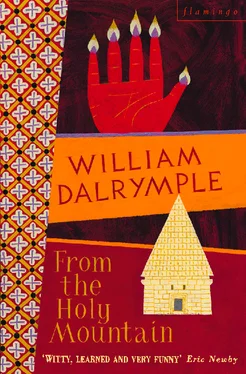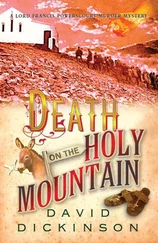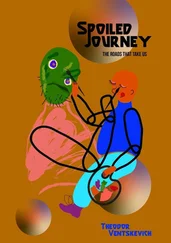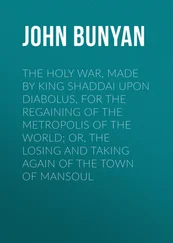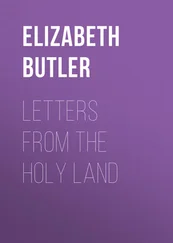The first monastic foundation on Athos was established in the ninth century by St Euthymius of Salonica who, having renounced the world at the age of eighteen, took to moving around on all fours and eating grass; he later became a stylite, and took to berating his brethren from atop a pillar. Some two hundred years later – by which time St Euthymius’s fame had led to many other monasteries and sketes springing up around the saint’s original foundation – it came to the ears of the Byzantine Emperor that the monks were in the habit of debauching the daughters of the shepherds who came to the mountain to sell milk and wool. Thereafter it was decreed that nothing female – no woman, no cow, no mare, no bitch – could step within its limits.
Today this rule is relaxed only for cats, and in the Middle Ages even a pair of Byzantine Empresses were said to have been turned away from the Holy Mountain by the Mother of God herself. But 140 years ago, in 1857, the Virgin was sufficiently flexible to allow one of my Victorian great-aunts, Virginia Somers, to spend two months in a tent on Mount Athos, along with her husband and the louche Pre-Raphaelite artist Coutts Lindsay. A letter Virginia wrote on her visit still survives, in which she describes how the monks had taken her over the monastery gardens and insisted on giving her fruit from every tree as they passed; she said she tasted pomegranate, citron and peach. It is the only recorded instance of a woman being allowed onto the mountain in the millennium-long history of Athos, and is certainly the only record of what appears to have been a most unholy Athonite ménage-à-trois .
This unique lapse apart, the Holy Mountain is still a self-governing monastic republic dedicated to prayer, chastity and pure, untarnished Orthodoxy. At the Council of Florence in 1439 it was Athonite monks who refused to let the Catholic and Orthodox Churches unite in return for Western military help against the Turk; as a result Constantinople fell to the Ottomans within two decades, but Orthodoxy survived doctrinally intact. That deep pride in Orthodoxy combined with a profound suspicion of all other creeds remains the defining ideology of Athos today.
I disembarked at Daphne, caught the old bus to the monastic capital at Karyes, then walked slowly down the ancient foot-polished cobbles, through knee-high sage and clouds of yellow butterflies, to the lavra *of Iviron.
The monks had just finished vespers. As it was a lovely balmy evening, many were standing around the courtyard enjoying the shade of the cypresses next to the katholikon . Fr. Yacovos, the guestmaster, was sitting on the steps of the domed Ottoman fountain, listening to the water dripping from the spout into the bowl. He stood up when he saw me enter the courtyard.
‘Welcome,’ he said. ‘We’ve been expecting you.’
Yacovos was a garrulous, thick-set, low-slung monk, bearded like a brigand. On his head, tilted at a jaunty angle, sat a knitted black bonnet. He took my bags and led me to the guest room, where he poured a glass of ouzo and offered me a bowl full of rose-scented loukoumi . As he did so, he chattered happily about his life in the merchant navy. He had visited Aberdeen on a Cypriot ship in the winter of 1959, he said, and had never forgotten the fog and the bitter cold. I asked where I could find the librarian, Fr. Christophoros. It had been Fr. Christophoros’s letter – surmounted by the great Imperial crest, the double-headed eagle of Byzantium – that had originally lured me to Athos. The manuscript I was looking for was in Iviron’s monastic library, he had said. Yes, it had survived, and he would try to get the Abbot’s permission for me to see it.
‘Christophoros will be down at the Arsenal at this time,’ said Fr. Yacovos, looking at his fob watch, ‘feeding his cats.’
I found the old man standing on the jetty, holding a bucket full of fishtails. A pair of enormous black spectacles perched precariously on his nose. Around him swirled two dozen cats.
‘Come, Justinian,’ called Fr. Christophoros. ‘Come now, Chrysostom, wisswisswisswiss … Come on, my darlings, ela , come …’
I walked up and introduced myself.
‘We thought you were coming last week,’ replied the monk, a little gruffly.
‘I’m sorry,’ I said. ‘I had trouble getting a permit in Thessaloniki.’
The cats continued to swirl flirtatiously around Christophoros’s ankles, hissing at each other and snatching at the scattered fins.
‘Have you managed to have a word with the Abbot about my seeing the manuscript?’
‘I’m sorry,’ said Christophoros. ‘The Abbot’s away in Constantinople. He’s in council with the Ecumenical Patriarch. But you’re welcome to stay here until he returns.’
‘When will that be?’
‘He should be back by the Feast of the Transfiguration.’
‘But that’s – what? – over a fortnight away.’
‘Patience is a great monastic virtue,’ said Christophoros, nodding philosophically at Kallistos, a rather scraggy, bow-legged old tom-cat who had so far failed to catch a single fishtail.
‘My permit runs out the day after tomorrow,’ I said. ‘They only gave me a three-day diamonitirion . I have to leave by the morning boat.’ I looked at the old monk. ‘Please – I’ve come all the way just to see this book.’
‘I’m afraid the Abbot insists that he must first question anyone who …’
‘Is there nothing you could do?’
The old man pulled tentatively at his beard. ‘I shouldn’t do this,’ he said. ‘And anyway, the lights aren’t working in the library.’
‘There are some lamps in the guest room,’ I suggested.
He paused for a second, indecisive. Then he relented: ‘Go quickly,’ he said. ‘Ask Fr. Yacovos: see if he’ll lend you the lanterns.’
I thanked Christophoros and started walking briskly back towards the monastery before he could change his mind.
‘And don’t let Yacovos start telling you his life story,’ he called after me, ‘or you’ll never get to see this manuscript.’
At eight o’clock, I met Fr. Christophoros outside the katholikon . It was dusk now; the sun had already set over the Holy Mountain. In my hands I held the storm lantern from my room. We walked across the courtyard to the monastic library, and from his habit Fr. Christophoros produced a ring of keys as huge as those of a medieval jailer. He began to turn the largest of the keys in the topmost of the four locks.
‘We have to keep everything well locked these days,’ said Christophoros in explanation. ‘Three years ago, in the middle of winter, some raiders turned up in motorboats at the Great Lavra. They had Sten guns and were assisted by an ex-novice who had been thrown out by the Abbot. They got into the library and stole many of the most ancient manuscripts; they also took some gold reliquaries that were locked in the sanctuary.’
‘Were they caught?’
‘The monks managed to raise the alarm and they were arrested the following morning as they tried to get across the Bulgarian frontier. But by then they had done much damage: cut up the reliquaries into small pieces and removed the best illuminations from the manuscripts. Some of the pages have never been recovered.’
Three locks had now opened without problem; and eventually, with a loud creak, the fourth gave way too. The old library doors swung open, and with the lamps held aloft, we stepped inside.
Within, it was pitch dark; a strong odour of old buckram and rotting vellum filled the air. Manuscripts lay open in low cabinets, the gold leaf of illuminated letters and gilt haloes from illustrations of saints’ Lives shining out in the light of the lantern. In the gloom on the far wall I could just see a framed Ottoman firman , the curving gilt of the Sultan’s monogram clearly visible above the lines of calligraphy. Next to it, like a discarded suit jacket, hung a magnificent but rather crumpled silk coat. Confronted dragons and phoenixes were emblazoned down the side of either lapel.
Читать дальше
